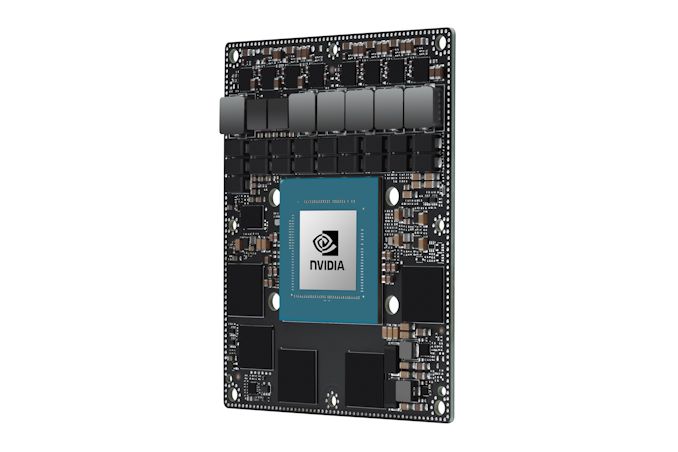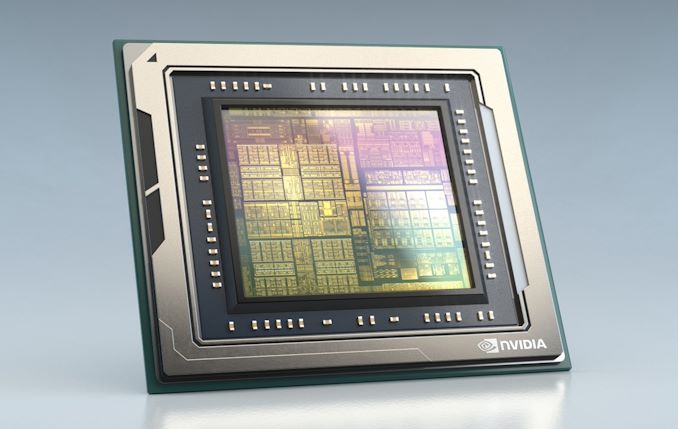NVIDIA Announces Jetson AGX Orin: Modules and Dev Kits Coming In Q1’22
by Ryan Smith on November 9, 2021 4:30 AM EST
Today as part of NVIDIA’s fall GTC event, the company has announced that the Jetson embedded system kits will be getting a refresh with NVIDIA’s forthcoming Orin SoC. Due early next year, Orin is slated to become NVIDIA’s flagship SoC for automotive and edge computing applications. And, has become customary for NVIDIA, they are also going to be making Orin available to non-automotive customers through their Jetson embedded computing program, which makes the SoC available on a self-contained modular package.
Always a bit of a side project for NVIDIA, the Jetson single-board computers have none the less become an important tool for NVIDIA, serving as both an entry-point for helping bootstrap developers into the NVIDIA ecosystem, and as a embedded computing product in and of itself. Jetson boards are sold as complete single-board systems with an SoC, memory, storage, and the necessary I/O in pin form, allowing them to serve as commercial off the shelf (COTS) systems for use in finished products. Jetson modules are also used as the basis of NVIDIA’s Jetson developer kits, which throw in a breakout board, power supply, and other bits needed to fully interact with Jetson modules.
| NVIDIA Jetson Module Specifications | |||||
| AGX Orin | AGX Xavier | Jetson Nano | |||
| CPU | 12x Cortex-A78AE @ 2.0GHz |
8x Carmel @ 2.26GHz |
4x Cortex-A57 @ 1.43GHz |
||
| GPU | Ampere, 2048 Cores @ 1000MHz |
Volta, 512 Cores @ 1377MHz |
Maxwell, 128 Cores @ 920MHz |
||
| Accelerators | 2x NVDLA v2.0 | 2x NVDLA | N/A | ||
| Memory | 32GB LPDDR5, 256-bit bus (204 GB/sec) |
16GB LPDDR4X, 256-bit bus (137 GB/sec) |
4GB LPDDR4, 64-bit bus (25.6 GB/sec) |
||
| Storage | 64GB eMMC 5.1 | 32GB eMMC | 16GB eMMC | ||
| AI Perf. (INT8) | 200 TOPS | 32 TOPS | N/A | ||
| Dimensions | 100mm x 87mm | 100mm x 87mm | 45mm x 70mm | ||
| TDP | 15W-50W | 30W | 10W | ||
| Price | ? | $899 | $99 | ||
With NVIDIA’s Orin SoC set to arrive early in 2022, NVIDIA is using this opportunity to announce the next generation of Jetson AGX products. Joining the Jetson AGX Xavier will be the aptly named Jetson AGX Orin, which integrates the Orin SoC.
Orin featuring 12 Arm Cortex-A78AE “Hercules” CPU cores and an integrated Ampere architecture GPU with 2048 CUDA cores, adding up to 17 billion transistors, Given Orin's mobile-first design, NVIDIA is being fairly conservative with the clockspeeds here; the CPU cores for Jetson AGX Orin top out at 2GHz, while the GPU tops out at 1GHz. Otherwise, the SoC also contains a pair of NVIDIA’s latest generation dedicated Deep Learning Accelerators (DLA), as well as a vision accelerator to further speed up and efficiently process those tasks.
Rounding out the Jetson AGX Orin package, the Orin SoC is being paired with 32GB of LPDDR5 RAM, which is attached to a 256-bit memory bus, allowing for 204GB/second of memory bandwidth. Meanwhile storage is provided by a 64GB eMMC 5.1 storage device, which is twice the capacity of the previous generation Jetson AGX.
All told, NVIDIA is promising 200 TOPS of performance in INT8 machine learning workloads, which would be a 6x improvement over Jetson AGX Xavier. Presumably those performance figures are for the module’s full 50W TDP, while performance is proportionally lower as you move towards the module’s minimum TDP of 15W.
Meanwhile, for this generation NVIDIA will be maintaining pin and form-factor compatibility with Jetson AGX Xavier. So Jetson AGX Orin modules will be the same 100mm x 87mm in size, and use the same mezzanine connector, making Orin modules drop-in compatible with Xavier.
Jetson AGX Orin modules and dev kits are slated to become available in Q1 of 2022. NVIDIA has not announced any pricing information at this time.
Source: NVIDIA












19 Comments
View All Comments
abufrejoval - Tuesday, November 9, 2021 - link
Would make a decent open source alternative to a M1 Mac mini or just a nice workstation, even gaming console. Too bad the prices won't be anywhere near the Jetson Nano, so unlike the Nano or a PI it won't fit into my 'toy allowance' and I'd have argue an actual use case to buy one...Alas, it is really tempting!
nandnandnand - Tuesday, November 9, 2021 - link
I'm not sure why the Jetson Nano is being compared to AGX Xavier. But the Jetson Xavier NX launched at $400, which is not ideal to those who want Jetson Nano prices, but a lot more affordable than the AGX Xavier.mode_13h - Tuesday, November 9, 2021 - link
The problem with Nano is that it's getting pretty ancient, by this point. It'd be great to have something in that price range, size, and power budget, but with newer ARM cores and modern tensor cores. Even Xavier NX still isn't a good fit for many projects and budgets.bondr - Tuesday, November 9, 2021 - link
Newer cores cost more to license and tend to be run on newer manufacturing process nodes, which are more expensive. Thus, they tend to mostly be used for parts which can be sold for more money. That's why Nvidia is just releasing a high-end SBC with new cores right now.The exception to this is smartphones, but that comes from the exceptional scale there.
bondr - Tuesday, November 9, 2021 - link
A good example of this: the Snapdragon 888 developer board costs nearly double what some Snapdragon 888 phones cost.mode_13h - Wednesday, November 10, 2021 - link
That's because it's intended at people doing commercial hardware development, not hobbyists, students, or the homebrew crowd.Frequently, hardware development kits can cost in the tens of thousands of dollars. They're simply not meant for the casual tinkerer that Nvidia is targeting with these kits.
mode_13h - Wednesday, November 10, 2021 - link
> Newer cores cost more to licenseHuh? Carmel is Nvidia's own design, as with probably all the rest of the IP in those chips!
> newer manufacturing process nodes
Yeah, so cut down the size and make it cheaper. That would also help with power, size, and cooling. You wouldn't need such a wide memory interface, either.
Again, there are lots of robotics projects that would like to go beyond Nano but there's no viable option.
bondr - Thursday, November 11, 2021 - link
All ARM cores are licensed IP from ARM. Nvidia just designed "on top" of the existing ARM IP, which they pay for. As a company, you will pay more to license newer ARM IP (e.g. that from the ARMv8.2-A ISA Carmel is based on).mode_13h - Friday, November 12, 2021 - link
> All ARM cores are licensed IP from ARM.Huh? Do you even know that Carmel is Nvidia's own clean-sheet design?
https://en.wikipedia.org/wiki/Project_Denver
Yes, even building your own ARM core requires requires an ISA license, but it's unlikely the ARMv8 ISA licenses cost more than licensing the actual design of the A57 cores they have in Jetson Nano.
Plus, I think it doesn't matter if it's trivially more expensive. It's not a deal-breaker if the successor is *a little* more expensive. It just can't be > 3x.
bondr - Thursday, November 11, 2021 - link
Also, the fact that Nvidia is doing custom ARM chips in-house is also a HUGE cost factor, and the division working on this can probably only focus on one chip release at a time. Take for contrast RasPi, where many have wished for custom designs. RasPi just did a custom microcontroller, but the engineering effort/cost to produce a full scale general purpose SoC is an order of magnitude higher. Nvidia can only afford the luxury of full custom SoC designs on the back of their other divisions and the expectation that the edge AI vertical will expand greatly in the future (and wanting to establish their dominance for the sector early), but the team is surely focused on one design at a time still.They obviously have a design cycle where they're going to keep updating Jetson. Since this Orin represents a new high end offering, it wouldn't be a surprise if their next release next year is a refresh on the low end.